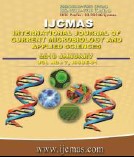


 National Academy of Agricultural Sciences (NAAS)
National Academy of Agricultural Sciences (NAAS)

|
PRINT ISSN : 2319-7692
Online ISSN : 2319-7706 Issues : 12 per year Publisher : Excellent Publishers Email : editorijcmas@gmail.com / submit@ijcmas.com Editor-in-chief: Dr.M.Prakash Index Copernicus ICV 2018: 95.39 NAAS RATING 2020: 5.38 |
Cassava mosaic disease (CMD) is caused by a number of distinct begomoviruses under the family Geminiviridae. In Indian subcontinent, Indian cassava mosaic virus (ICMV) and Sri Lankan cassava mosaic virus (SLCMV) were reported to be associated with CMD. Although CMD is naturally transmitted by the whitefly (Bemisia tabaci Genn.). While infected stem cuttings is another mean. Natural occurrence of CMD in farmers’ field and in the experimental field of the AICRP on Tuber Crops, BCKV was recorded and the virus was detected by PCR-based method. 61-92% incidence was recorded in farmers’ fields of North 24 -Parganas and Nadia districts of West Bengal and variable symptom with mild chlorotic pattern to severe mosaic and distortion of leaf was observed. The incidence and severity of CMD among eight cassava varieties viz. H-5/78, Sree Jaya, Sree vijaya, Sree Prakash, H-118, H–165, CL-590, H-119 was screened and differential response to noticed among the varieties. The intensity of CMD varied significantly with plant age and severity was recorded to be highest at maturity stage. The whitefly mediated artificial inoculation showed the highest (40.0%) infection in H-118, while, the lowest (6.66%) infection was noted in Sree Vijaya and H-119. The PCR-based detection confirmed the presence of begomovirus in the symptomatic cassava plant samples. Furthermore, the sequence analysis of 511 bp long PCR fragment (FN691429) showed >90% homology with the SLCMV isolates of India but exhibited somewhat distant relation to SLCMV isolates of Colombo and ICMV. Further characterization of this reported isolate of SLCMV in this state is in progress.
 |
 |
 |
 |
 |